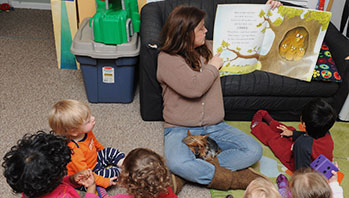- plant
- problem
- solution
MA Standards:
English Language Arts/Literature/RL.PK.MA.1 With prompting and support, ask and answer questions about a story or a poem read aloud.
English Language Arts/Literature/RL.PK.MA.4 With prompting and support, ask and answer questions about unfamiliar words in a story or poem read aloud.
English Language Arts/Literature/RL.PK.MA.10 Listen actively as an individual and as a member of a group to a variety of age-appropriate literature read aloud.
Head Start Outcomes:
Literacy Knowledge/Book Appreciation and Knowledge Asks and answers questions and makes comments about print materials.
PreK Learning Guidelines:
English Language Arts/Reading and Literature 6 Listen to a wide variety of age appropriate literature read aloud.
English Language Arts/Reading and Literature 10 Engage actively in read-aloud activities by asking questions, offering ideas, predicting or retelling important parts of a story or informational book.
Read Together: Chicks and Salsa #1

© Commonwealth of Massachusetts, Department of Early Education and Care (Jennifer Waddell photographer). All rights reserved.
STEM Key Concepts: Plants grow in many places; Many foods that animals, including humans, eat come from plants; We eat certain leaves, roots, fruits, and seeds
ELA Focus Skills: Appreciating Diversity, Concepts of Print, Listening and Speaking, Story Comprehension (Plot), Vocabulary
Before You Read
Hold up the book cover for children to see. Ask a volunteer to point to the book title. Read the title aloud for children. Then ask a volunteer to point to the author and illustrator names. Read aloud the names and ask children to tell you what an author and illustrator do.
Take children on a picture walk through the book. Ask them to name the farm animals. (rooster, chickens, ducks, pigs, horses, etc.) Then set a listening focus. Say, The animals in the story have a problem. They are tired of eating the same food all the time. As I read the book, I want you to think about how the animals solve this problem. What is their solution? Explain to children that a solution is how a problem is fixed or solved.
As You Read
- Read slowly and with expression. Change your voice to stress words and highlight objects.
- Pause and have children chime in whenever you come to the word olé. Ask if any children know the meaning of the word. Explain that it is a Spanish word, and it is an expression of excitement.
- Pause and identify different plant foods, such as tomatoes, onions, chilies, and grapes.
After You Read
Discuss the book with children. Help them recall important plot elements of the story by asking questions such as,
- What was the animals’ problem? What was the animals’ solution?
Guide children to talk about how the rooster inspired the others to “spice” up dinnertime by introducing new foods into their “cuisine.”
Take It Further: Encourage children to make a text-to-self connection. Ask, Have you ever been on a farm? Have you ever given food to a duck or a horse? What did you feed them?
Social Emotional Tip: Help children develop their self-concept by asking them to talk about their food preferences. Are there any foods they are tired of eating, like the farm animals? What foods would they like to eat instead? What are their favorite foods?
Cultural Connection: Talk with children about the Spanish and French words in the book. Ask, What word do the rooster, ducks, and pigs say when they finish eating? Say, Olé is a Spanish word that people say when they like something, when something is done well, or when they feel happy. Let me hear you say it—Olé! Ask, What word do you say when you have done well or are happy? Turn to the illustration on the last page and say, What does the rooster say when he is making the French crêpes —he says “Ooh, la, la!” “Ooh, la, la” is an expression people use when they are happy about something. Ask, What word do you say when you are happy?
Cultural Connection: This book offers an opportunity to engage children to share any ethnic foods they eat at home. Invite children to talk about what foods they are served at home. Encourage them to name the ingredients in favorite dishes and what they know about how they are prepared.
